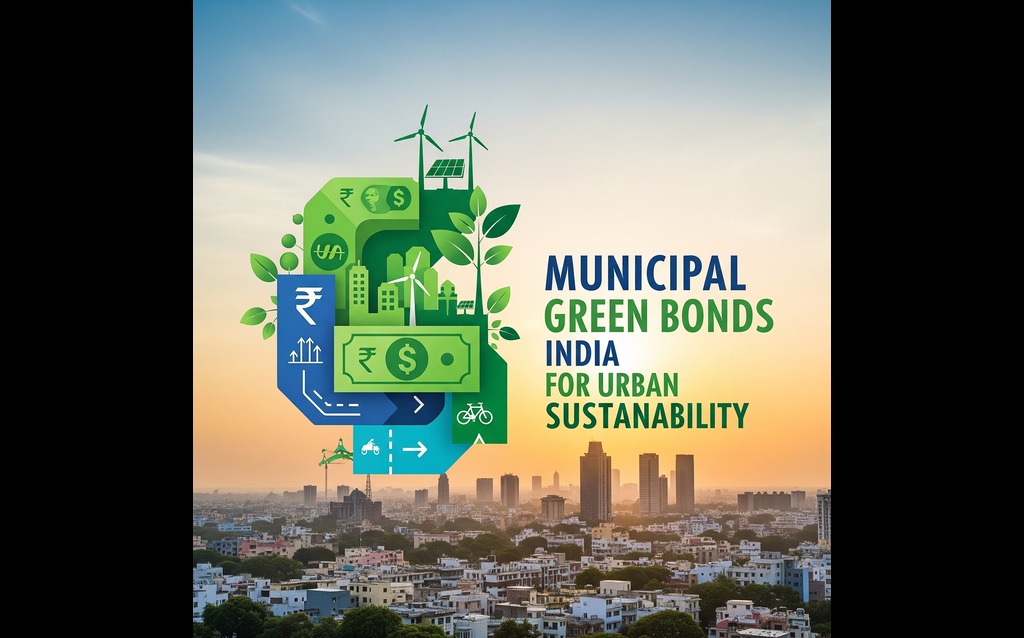Green Finance for Urban Local Bodies through Municipal Green Bonds in India
Cities have grown both quickly and tremendously in India and the process has been associated with numerous issues facing urban management. The finances of urban local bodies in India are under pressure because they are expected to deliver basic civic services like water supply, sanitation, and waste management while also planning for long-term development. They do not however have large revenues and their reliance on grants given to them by state or central governments is also very high. In collaboration, the issue of climate change, pollution, and resource exhaustion, it is evident that the development of urbanism should be sustainable. It is here that the concept of green finance comes in. Green bonds have now come up in the world as a method of financing projects that guard the environment. India too has entered this space, and now the idea of municipal green bonds is gaining attention as a tool for cities to finance their sustainable growth.

Finances of Urban Local Bodies in India
The city level governance is rendered by urban local bodies (ULBs). They play a central role since they are on the frontline to deal with issues that affect the masses; they are those in charge of day to day activities, such as roads, drainage, public health, solid wastes, and so on. However, the finances of urban local bodies in India are limited due to low property tax collection, weak revenue-generating capacity, and dependence on higher government transfers.
This financial gap is even more serious as the cities in India expand. It is usually quite difficult for ULBs to take care of even the basic infrastructure, and even more so to provide the funding to establish new projects such as renewable energy systems or modern waste management facilities. The traditional sources of funding are inadequate, and innovative financing is necessary as otherwise cities may be left to lag behind in terms of service delivery and sustainability.
Understanding Green Bonds India
Globally, green bonds are financial instruments used to raise funds for projects that have clear environmental benefits. Investors buy these bonds with the assurance that their money will support clean energy, climate adaptation, or sustainable urban infrastructure. In recent years, green bonds India have gained attention, with several companies and institutions issuing them. For cities, municipal green bonds are a more targeted version, designed specifically for urban projects. For example, a city could issue bonds to fund solar-powered streetlights, electric buses, or efficient sewage treatment plants. The benefit for investors is two-fold: financial returns and measurable environmental impact. For Indian cities, this offers an alternative to over-reliance on grants and loans, creating fresh avenues for financing.
Role of Urban Local Bodies in Sustainable Development
The role of urban local bodies is not limited to providing basic amenities. Today, they are expected to address environmental challenges, improve quality of life, and create resilient cities. When ULBs plan projects that reduce carbon emissions, improve air quality, or save energy, they are directly contributing to India’s climate goals as well. For instance, investing in eco-friendly public transport reduces traffic pollution and benefits public health. Similarly, waste-to-energy plants and rainwater harvesting projects make cities more sustainable. However, these projects require upfront capital. Municipal green bonds allow local bodies to align their responsibilities with long-term sustainable financing, ensuring that growth does not harm the environment but instead strengthens it.
Municipal Green Bonds: Opportunities and Challenges
The concept of municipal green bonds is not very old in India, yet it has a lot of potential. Across the world, cities such as New York and Johannesburg have used them with great success to finance large-scale sustainable initiatives. In India, Pune was one of the first cities to issue municipal bonds, and now green variants of those bonds are being considered. The benefits are obvious—local authorities have access to green project finance funds, investors have clarity on the usage of their capital, and residents enjoy cleaner and healthier city spaces.
But there are problems. Most ULBs do not have the technical knowledge of bond structuring, financial reporting, or satisfying investor expectations. Poor financial health and credit ratings further make it difficult for them to find takers. Transparency and accountability are essential, as investors need to be sure that the funds will be spent correctly. Despite these challenges, the long-term advantages outweigh the challenges. With adequate training, policy backing, and regulatory environments, more cities can issue municipal green bonds and expand their green projects.
Future of Green Finance for Indian Cities
As India moves toward becoming an urban-majority nation, cities will play a central role in shaping the country’s environmental and economic future. The finances of urban local bodies in India need strengthening, and green finance is one of the ways to bridge the funding gap. The growth of green bonds India provides a strong foundation, and municipal green bonds can take it further by linking sustainable finance directly to local governance. If widely adopted, these bonds can transform Indian cities into hubs of clean energy, sustainable mobility, and efficient resource management.
International investors are also looking for opportunities in emerging markets where sustainability is a priority. By issuing municipal green bonds, Indian cities can attract global capital and partnerships. More importantly, this process also builds trust among citizens, because it increases transparency and shows visible improvements in daily life—whether through cleaner air, reliable waste management, or better public transport.
Conclusion: Building Resilient Urban Futures
In conclusion, municipal green bonds are more than just a financial instrument; they are a pathway for cities to grow responsibly. The role of urban local bodies in this journey is crucial, as they are the ones who can design and implement sustainable projects at the ground level. By adopting green bonds in India, they can overcome financial constraints, improve transparency, and create inclusive, climate-friendly urban spaces. While challenges remain, the future of municipal green bonds is promising if backed by strong policy frameworks, investor trust, and citizen engagement. Ultimately, this approach humanises urban finance by linking it directly with cleaner air, healthier communities, and better living standards for millions of people in Indian cities.
Frequently Asked Questions (FAQs)
A green municipal bond funds projects with positive environmental impact, such as renewable energy, waste treatment, or green mobility. The issuer commits to using proceeds only for these purposes and must often report on environmental outcomes.
Like all bonds, these carry credit risk, interest rate risk, and project execution risk. However, proper due diligence, regulatory oversight, and transparency measures significantly reduce these concerns.
Institutional investors like pension funds, insurance companies, and banks, as well as retail investors, can invest—depending on the bond’s terms and regulations.
They channel funds to projects that directly reduce emissions, improve air and water quality, and enhance climate resilience at the urban level.
SEBI (Securities and Exchange Board of India) has issued guidelines for green bond issuance to ensure standardization, transparency, and credibility.












